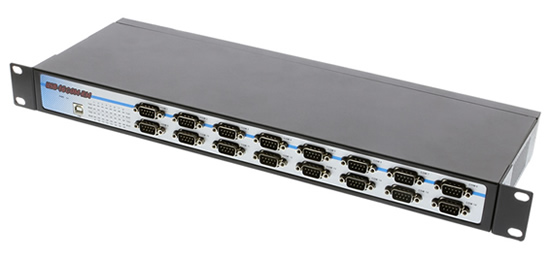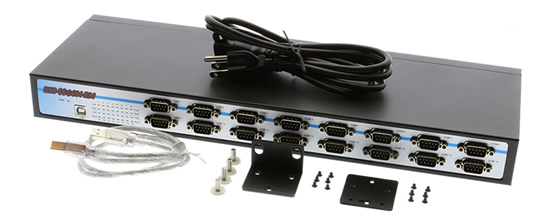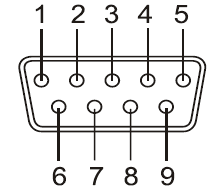Standards:
USB 2.0 Hubs
USB 3.0 (3.2 Gen 1) Hubs
USB 3.2 Gen 2 Hubs
USB Type-C Hubs
The USB-16COM-RM is a 16 Port RS-232 industrial style USB to Serial adapter, which allows the use of sixteen new RS-232 serial ports by connecting to a host USB port.
The USB-16COM-RM USB to 16 Port RS-232 Serial Adapter is designed for industrial applications and environments for an easier user experience of expanding serial ports. When using a host USB port on your computer or USB hub, the USB 16 Port RS-232 Serial Adapter instantly adds sixteen (16) new RS-232 serial communication ports to your system.

By using Plug-and-Play features the USB Serial Adapter is installed without the need for configuration and can make use of hot plug abilities. The adapter 16 Port RS-232 Rack Mountable serial adapter is automatically detected and installed. There are no IRQ & COM port conflicts, since the ports do not require any additional IRQ, DMA, memory as resources on the system. The adapter is self-powered, and has built-in switching power supply of 100V/240V (input) inside the chassis.

The adapter is with DIN rail bracket for industrial application environments. The adapter can also be mounted to a 19 inches rack, the rack mount kits are included with the adapter package. The USB 16COM Serial Adapter provides instant connectivity with modems, ISDN TAs, PDAs, handheld & pocket PCs, digital cameras, POS, serial printers. It is suitable for remote access, retail and industrial applications, data collection and other applications requiring high speed RS-232 serial communication ports.
Additional Features & Specifications:
Environmental Specifications:
Product Dimensions: 16.889in(L) x 5.787in(W) x 1.733in(H) with DB9 connector and ears.
OS Support:
*Surface Mounting screws not included.
| Compliance |
| ||||||||||||
|---|---|---|---|---|---|---|---|---|---|---|---|---|---|
| Physical Characteristics |
| ||||||||||||
| Serial Attributes |
| ||||||||||||
| Software |
| ||||||||||||
| Environmental |
| ||||||||||||
| Hardware |
| ||||||||||||
| Other Data |
|
| USB Bus | |
| Compliance | USB 1.1/2.0 compatible |
| Speed | 480 Mbps, hi-speed USB |
| FIFO | 128 byte transmit FIFO 384 receive FIFO |
| Serial Interface | |
| Port Type | RS-232 |
| Number of Ports | 16 |
| Connectors | DB9 male |
| Serial Line Protection | |
| ESD Protection | 10KV |
| Serial Port Speed | |
| Baudrate | 300 bps to 921.6k bps |
| Serial Communication Parameters | |
| Data Bits | 7, 8 |
| Stop Bits | 1, 1.5, 2 |
| Parity | None, Even, Odd, Space, Mark |
| Flow Control | RTS/CTS, XON/XOFF |
| Serial Signals | |
| RS-232 | TxD, RxD, RTS, CTS, DTR, DSR, DCD, GND, RI |
| Driver Support | |
| OS | Windows 7, Vista, 2003, XP (WHQL certified) and 2000 Linux Kernel 2.6.3.1 and up built-in support |
| Power Supply | |
| Input | Self-powered Built-in AC to DC switching power supply with wide range of AC input from 100VAC to 240VAC |
| Mechanical | |
| Chassis | SECC metal chassis with DIN rail bracket Rack-mounting brackets included |
| Environmental | |
| Operating Temperature | 0 to 55 °C (32 to 131 °F) |
| Operating Humidity | 5 to 95% RH |
| Storage Temperature | -20 to 75 °C (-4 to 167 °F) |
| Safety Approvals | EN55022 Class B, EN55024, EN61000-3-2, EN61000-3 IEC 61000-4-2, IEC 61000-4-3, IEC 61000-4-4, IEC 61000-4-5, IEC 61000-4-6, IEC 61000-4-8, IEC 61000-4-11. CISPR PUB. 22 and FCC Part 15 Class B. |
| RS-232 DB9 Male | ||||||||||||||||||||||||||||||||||||||||
|
RS-232 DB9 Male Connector Pin-outs |
RS-232 Signal Pin-outs of DB-9 Male |
|||||||||||||||||||||||||||||||||||||||
 |
|
|||||||||||||||||||||||||||||||||||||||
The 16 Port RS-232 Rack Mountable USB to Serial Adapter has certain accessories that work with it. These accessories are what you can order if needed.
View frequently asked product questions below. For all serial troubleshooting, visit this page.
Still need help? Reach out!
Test your components by:
When testing cables:
When testing serial ports and devices:
Note: You are required to restart your computer after disabling the Driver Signature Enforcement. Save all open work on your computer.
Disable driver signature enforcement:
When your system restarts:
When your computer restarts, Driver Signature Enforcement will be disabled and you can install the drivers.
Note: You are required to restart your computer after disabling the Driver Signature Enforcement. Save all open work on your computer.
Disable Driver Signature Enforcement:
After your computer restarts:
When your computer restarts, Driver Signature Enforcement will be disabled and you can install the drivers.
Once the driver/software is installed, follow these steps to allow the software: